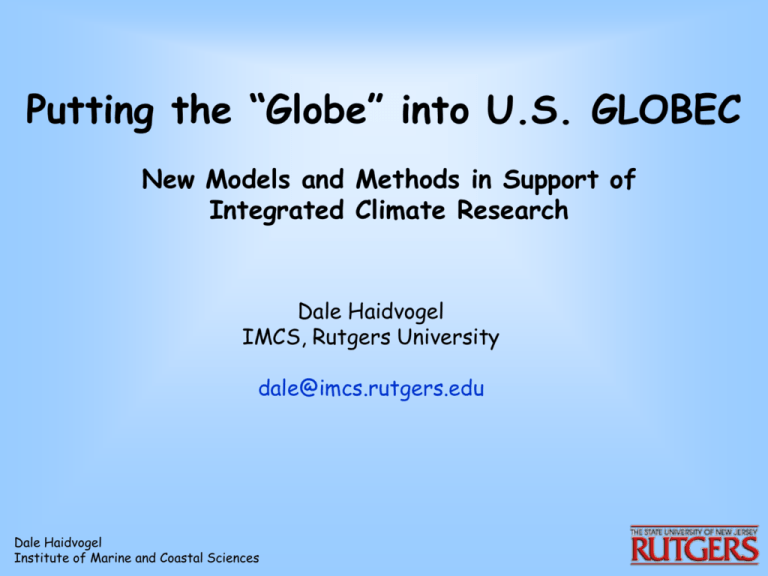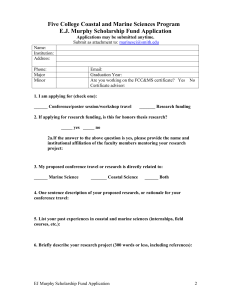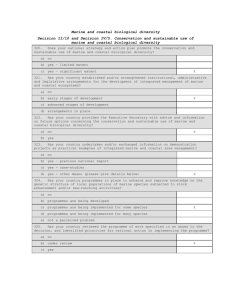Putting the "GLOBE" in US GLOBEC
advertisement

Putting the “Globe” into U.S. GLOBEC New Models and Methods in Support of Integrated Climate Research Dale Haidvogel IMCS, Rutgers University dale@imcs.rutgers.edu Dale Haidvogel Institute of Marine and Coastal Sciences Outline 1. U.S. GLOBEC as an example of new approaches to Integrated Climate Research 2. Requirements for Pan-Regional Synthesis 3. Status and skill of end-to-end systems 4. Next steps Dale Haidvogel Institute of Marine and Coastal Sciences U.S. GLOBEC The principal objective of U.S. GLOBEC research is to understand and predict the effects of global climate change on ocean ecosystem dynamics Dale Haidvogel Institute of Marine and Coastal Sciences U.S. GLOBEC Study Areas & Principal Target Species Gulf of Alaska Georges Bank Copepods Euphausiids Pink Salmon Copepods Atlantic Cod Haddock California Current Copepods Euphausiids Coho Salmon Chinook Salmon Southern Ocean Dale Haidvogel Institute of Marine and Coastal Sciences Krill U.S. GLOBEC Study Areas & Physical Processes Gulf of Alaska Stratification Buoyancy-Driven Flow Downwelling Cross-Shelf Exchange Georges Bank Stratification Retention/Loss Cross-Front Exchange California Current Stratification Upwelling/Downwelling Cross-Shelf Exchange Southern Ocean Dale Haidvogel Institute of Marine and Coastal Sciences Stratification Sea Ice Dynamics Retention/Loss Goals of U.S. GLOBEC Synthesis • Undertake regional and pan-regional synthesis and comparisons among U.S. GLOBEC study locations and international programs to understand the impacts of climate change and variability on selected target species and marine ecosystems • Integrate process-oriented, observational, and retrospective studies through conceptual and mathematical models • Bridge the nested spatial/temporal scales of these GLOBEC program elements through modeling to understand climates-scale impacts • Develop tools needed to predict the responses of populations and ecosystems to global climate change and climate variability • Contribute to management of living marine resources in an ecosystem context Dale Haidvogel Institute of Marine and Coastal Sciences U.S. GLOBEC Approach to Integrated Climate Research Climate Model Mass Balance Network Models Sea Ice Individual-Based Population Models Dale Haidvogel Institute of Marine and Coastal Sciences Prey Fields Climate Model Biases Dale Haidvogel Institute of Marine and Coastal Sciences SST (20 August 2000) ROMS NEP Grid (10 km) Dale Haidvogel Institute of Marine and Coastal Sciences POP Multi-scale modeling in the North Pacific Dale Haidvogel Institute of Marine and Coastal Sciences Status of Three Regional Domains Curchitser, Hedstrom, Powell, Hermann, Moore, Haidvogel Δx Now Next When? NPac 0.18o 19581978 19782006 As time permits NEP 10 km 19582004 Add tides Soon CCS 3 km 2000 20002004† 1-2 months † Dale Haidvogel Institute of Marine and Coastal Sciences Adjoint-based assimilation NEP Implementation Domain: 20 - 73N, 115 – 210E ROMS: 226 x 642 x 42 gridpoints Subdaily (6 hr) T42 CORE wind and fluxes (Large and Yeager) Initial/boundary conditions provided by CCSM-POP hindcast model Forward run for 1958-2004—includes multiple El Nino’s, regime shifts, and 2002 cold intrusion Outputs: Daily averaged physical snapshots of velocity, temperature, etc. Dale Haidvogel Institute of Marine and Coastal Sciences 1961-75 Dale Haidvogel Institute of Marine and Coastal Note: Left panel is May only;Sciences Right is Annual +PDO From Schwing et al. (2002) 1978-96 -PDO The 1976-77 Regime Shift SST Patterns Northward Velocity – Newport Line - July 1997 7-8 July 2000 2000 1998 Well defined core of California Under Current in 1997, 1998, 2000; close to slope Dale Haidvogel Institute of Marine and Coastal Sciences Northward Velocity – Newport Line - July 9-11 July 2002 2002 1999 Weaker, more diffuse California Under Current in 1999 & 2002; not adjacent to slope Dale Haidvogel Institute of Marine and Coastal Sciences Next Steps 1. Fully integrate ROMS within CCSM (underway @ NCAR) 2. Demonstration in multiple physical settings (pilot projects) 3. Engage wider community (e.g., CLIVAR, IMBER) (conference) Dale Haidvogel Institute of Marine and Coastal Sciences






